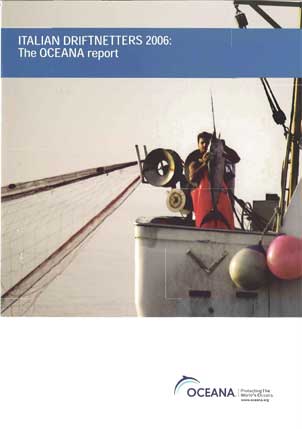Report | May 3, 2010
Italian driftnetters 2006: The Oceana report
Driftnetting has been condemned by the international community, banned in EC waters and on the high seas by EU flagged vessels by the European Union in 2002, and by the General Fisheries Commission for the Mediterranean (GFCM)in waters of the Mediterranean Sea since 2005. Years after the prohibition became effective, however, there are still various fleets from different countries using this fishing method. Within this context, the Italian driftnetting fleet is one of the most significant, not only due to the number of vessels that currently make-up the fleet, but also due to the fact that this fleet has received more than 200 million Euros, from European and Italian funding, in subsidies for its conversion or dismantling. The continued and unpunished activity of this illegal fleet, with the connivance of the Italian authorities and the apparent passive stance by the European institutions, is completely unacceptable.
During June and July 2006, Oceana has travelled 1500 nautical miles on board the Oceana Ranger in order to identify, document and report the vessels in this fleet engaged in Illegal, Unregulated and Unreported (IUU) fishing in the Tyrrhenian Sea, Sicily and the south of Sardinia. Similarly, this work has been complemented by the inspection of ports in the regions of Sardinia, Campania, Calabria and Sicily, where the presence and activities related to this illegal fishing fleet have been discovered in 14 of these ports. The results have also been complemented by those obtained during the 2005 campaign, presented in the Oceana report titled “The use of driftnets: a scandal for Europe, a mockery of the United Nations.”
As a result of this investigation, 71 illegal driftnetters have been documented, either carrying out their fishing activities or set-up in order to do so, and of these, it has been proven that 22 have received subsidies for their conversion. The average length of the nets used by these vessels is an estimated 8 kilometres, 3 times the limit established by the European legislation, and sometimes reaching up to 20 kilometres in length.
During the observations made on the high seas, the capture of swordfish (Xiphias gladius) and albacore (Thunnus alalunga) has been filmed and photographed, a fishing activity which was banned by EC legislation regardless of net length, as well as the illegal landing of these species at port, and their subsequent introduction into the markets. Furthermore,an analysis has been conducted regarding the possible causes that have benefited not only the continuance of these vessels, but also the new additions to this fishery that were made after the EU ban in came into effect.
In the following document, Oceana makes recommendations to the Italian government in order for it to completely eliminate the use of driftnets on their coasts. Similarly, Oceana insists that the European Union take the necessary measures to enforce current legislation in all member states.


